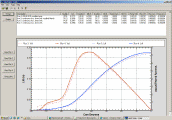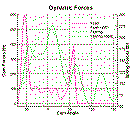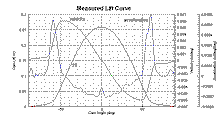Products & Services
Custom Cam Design
Do you have a car that is not mainstream, such as an older sports car? Do you have special engine requirements, such as one that is hopped up for vintage racing? Are you tired of using a cam grind that is recycled from a mainstream engine, such as a SBC? Was your engine and cam detuned to meet 1970's pollution controls? Do you even know what grind you have? If you take the time to find out what cam you have, you might be surprised that it is not as advertised.
We have been there. Every time we have taken detailed measurements on a performance camshaft we have found problems with the grind. For our vintage race Triumph TR3, we discovered that most cam grinds were designed to run on a SBC lifter, so I suspect they were recycled SBC grinds. Most of the grinds were not at all aggressive, lazy slow opening grinds, with much longer than advertised seat-to-seat duration. Utilizing all of the larger TR3/4 lifter (0.935 in vs. 0.842 in for a SBC) pays immediate dividends - faster opening, higher lift and more area under the lift curve.
We will design a cam specifically for your engine and your requirements. This is not just a design process. We will first survey the cams available for your engine. If a suitable cam is already available, we will recommend it rather than a custom design. More likely, we will utilize the information gained and develop a better grind. We can also perform or assist you with dyno testing to select from two or more custom grinds. We can take the development process to the level that you desire.
Triumph Cams
To date we have designed five Triumph TR2/3/4 cams, 4 race cams and 1 high performance street cam. The development of these cams and how they compare to others is detailed under Triumph Cams on the Technical Pages. Other Triumph cams, including six cylinder cams, will be coming in the near future. If you would like to obtain one of these cams, contact us.
Cam Design Software
 We
have developed a unique approach to camshaft design in our
Opticam™
software (click on image at left to enlarge). It uses splines
rather than the more common incomplete polynomial approach.
The spline technique is implemented so that once you specify the cam
duration and maximum values for velocity, acceleration and jerk, it
will produce the highest possible lift and greatest possible area
under the lift curve. The resulting grind will have the
greatest potential for engine performance.
We
have developed a unique approach to camshaft design in our
Opticam™
software (click on image at left to enlarge). It uses splines
rather than the more common incomplete polynomial approach.
The spline technique is implemented so that once you specify the cam
duration and maximum values for velocity, acceleration and jerk, it
will produce the highest possible lift and greatest possible area
under the lift curve. The resulting grind will have the
greatest potential for engine performance.
You can license Opticam™ if you prefer to design your own camshaft rather than have us design one for you.
Valve Train Dynamics
 We
have also developed state-of-the art valve train dynamics software.
The graph at left (click on it to enlarge) shows the forces in the
valve train during and immediately after the lift event. The
green lines are for an ideal valve spring and for the actual spring
accounting for so called
spring surge. The red lines show the force
between the cam and lifter for both an ideal stiff valve train and
the actual one. We always perform these calculations for a new
cam design to insure that stresses at the lifter will not be
excessive and that the valve spring will maintain contact between
the cam and lifter, avoiding valve float.
We
have also developed state-of-the art valve train dynamics software.
The graph at left (click on it to enlarge) shows the forces in the
valve train during and immediately after the lift event. The
green lines are for an ideal valve spring and for the actual spring
accounting for so called
spring surge. The red lines show the force
between the cam and lifter for both an ideal stiff valve train and
the actual one. We always perform these calculations for a new
cam design to insure that stresses at the lifter will not be
excessive and that the valve spring will maintain contact between
the cam and lifter, avoiding valve float.
Valve train dynamics calculations will soon be part of Opticam™. Until then, we can perform these calculations for you and avoid many potential pitfalls in a cam design.
Cam Profiling
 Cam
profiling is the measurement of the cam lift curve. A
degree wheel
and dial indicator can be used for this purpose, but it is time
consuming and sometimes greater accuracy is needed. A degree
wheel cannot accurately measure acceleration and jerk. The
graph at left (click to enlarge) was measured using our
precision hardware/software cam profiling system. The cam
profiling systems that are available commercially are currently
quite expensive. We are
developing a cam profiling package which is accurate and inexpensive.
Until then, we can profile your cam for you, if you send it to
us.
Cam
profiling is the measurement of the cam lift curve. A
degree wheel
and dial indicator can be used for this purpose, but it is time
consuming and sometimes greater accuracy is needed. A degree
wheel cannot accurately measure acceleration and jerk. The
graph at left (click to enlarge) was measured using our
precision hardware/software cam profiling system. The cam
profiling systems that are available commercially are currently
quite expensive. We are
developing a cam profiling package which is accurate and inexpensive.
Until then, we can profile your cam for you, if you send it to
us.